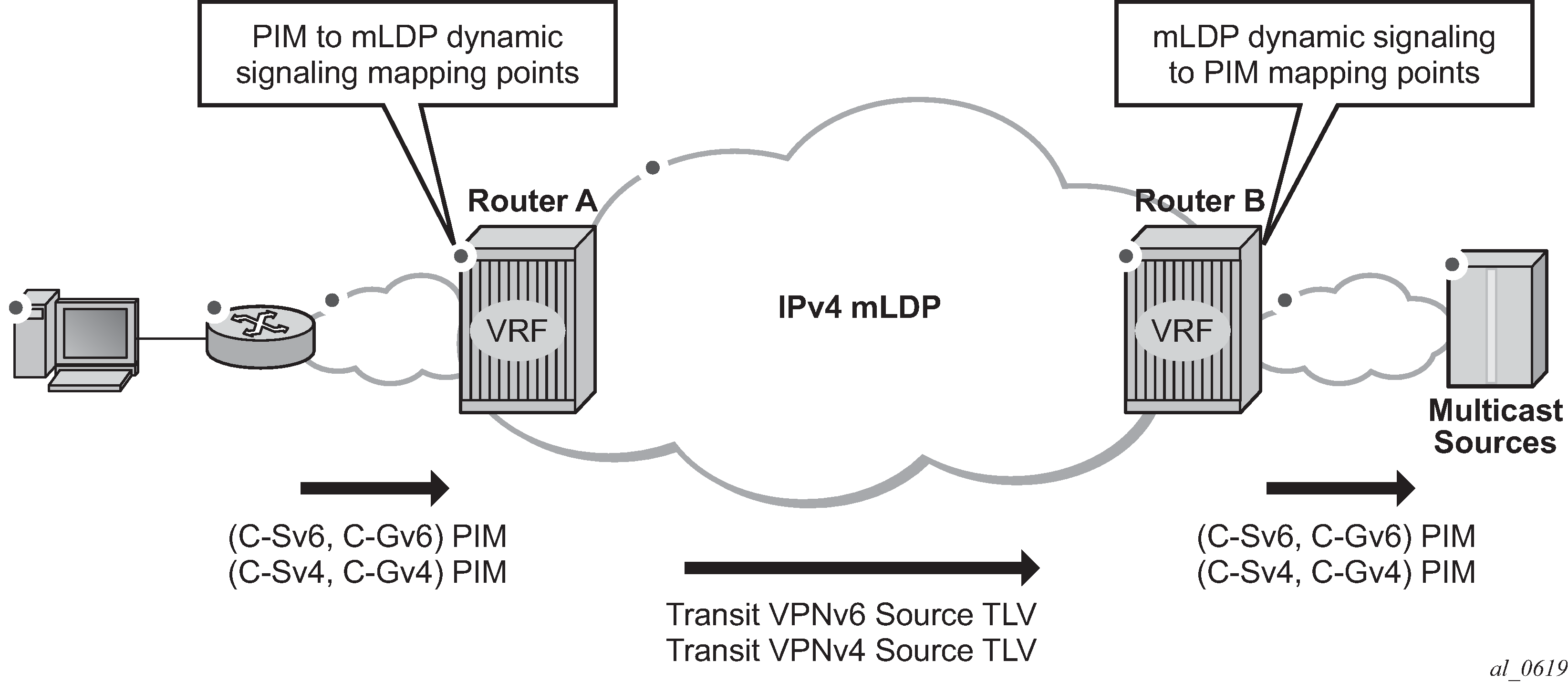This feature provides a multicast signaling solution for IP-VPNs, allowing the connection of IP multicast sources and receivers in C-instances, which are running PIM multicast protocol using Rosen MVPN with BGP SAFI and P2MP mLDP in P-instance. The solution dynamically maps each PIM multicast flow to a P2MP LDP LSP on the source and receiver PEs.
The feature uses procedures defined in RFC 7246: Multipoint Label Distribution Protocol In-Band Signaling in Virtual Routing and Forwarding (VRF) Table Context. On the receiver PE, PIM signaling is dynamically mapped to the P2MP LDP tree setup. On the source PE, signaling is handed back from the P2MP mLDP to the PIM. Because of dynamic mapping of multicast IP flow to P2MP LSP, provisioning and maintenance overhead is eliminated as multicast distribution services are added and removed from the VRF. Per (C-S, C-G) IP multicast state is also removed from the network, because P2MP LSPs are used to transport multicast flows.
Figure: Dynamic mLDP signaling for IP multicast in VPRN illustrates dynamic mLDP signaling for IP multicast in VPRN.

As illustrated in Figure: Dynamic mLDP signaling for IP multicast in VPRN, P2MP LDP LSP signaling is initiated from the receiver PE that receives PIM JOIN from a downstream router (Router A). To enable dynamic multicast signaling, the p2mp-ldp-tree-join must be configured on PIM customer-facing interfaces for the specific VPRN of Router A. This enables handover of multicast tree signaling from the PIM to the P2MP LDP LSP. Being a leaf node of the P2MP LDP LSP, Router A selects the upstream-hop as the root node of P2MP LDP FEC, based on a routing table lookup. If an ECMP path is available for a specific route, then the number of trees are equally balanced toward multiple root nodes. The PIM joins are carried in the Transit Source PE (Router B), and multicast tree signaling is handed back to the PIM and propagated upstream as native-IP PIM JOIN toward C-instance multicast source.
The feature is supported with IPv4 and IPv6 PIM SSM and IPv4 mLDP. Directly connected IGMP/MLD receivers are also supported, with PIM enabled on outgoing interfaces and SSM mapping configured, if required.
The following are feature restrictions:
Dynamic mLDP signaling in a VPRN instance and Rosen or NG-MVPN are mutually exclusive.
A single instance of P2MP LDP LSP is supported between the receiver PE and Source PE per multicast flow; there is no stitching of dynamic trees.
Extranet functionality is not supported.
The router LSA link ID or the advertising router ID must be a routable IPv4 address (including IPv6 into IPv4 mLDP use cases).
IPv6 PIM with dynamic IPv4 mLDP signaling is not supported with EBGP or IBGP with IPv6 next-hop.
Inter-AS and IGP inter-area scenarios where the originating router is altered at the ASBR and ABR respectively, (therefore PIM has no way to create the LDP LSP toward the source), are not supported.
When dynamic mLDP signaling is deployed, a change in Route Distinguisher (RD) on the Source PE is not acted upon for any (C-S, C-G)s until the receiver PEs learn about the new RD (via BGP) and send explicit delete and create with the new RD.
Procedures of Section 2 of RFC 7246 for a case where UMH and the upstream PE do not have the same IP address are not supported.